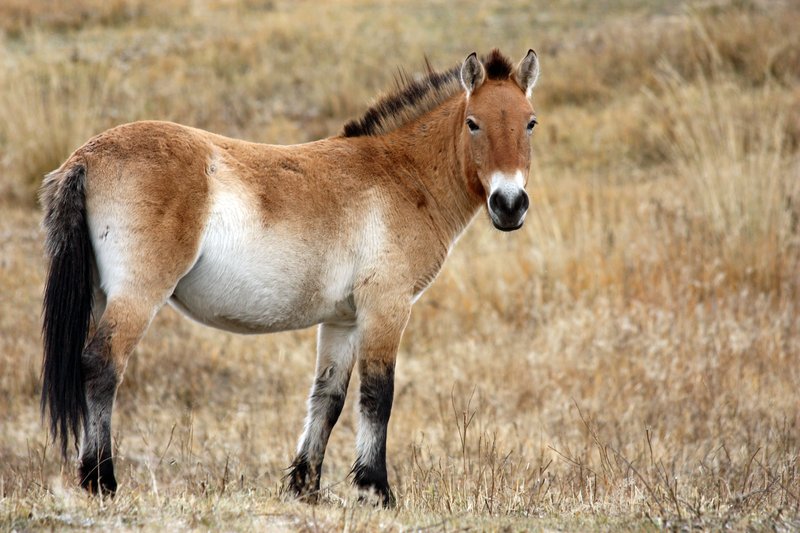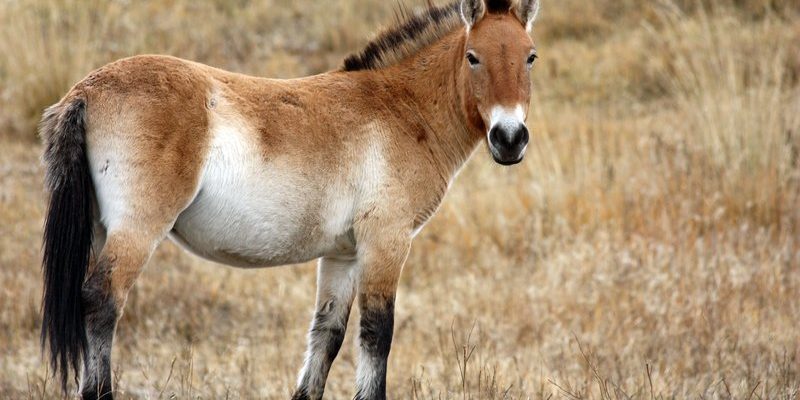
You might be wondering: what makes Przewalski’s horse so special? Well, this horse isn’t just any ordinary horse. It’s considered the only true wild horse left in the world. While domestic horses descended from a common ancestor and have been domesticated for thousands of years, Przewalski’s horse has never been domesticated. This makes it a living link to a time when horses roamed freely across vast terrains. Let’s dive into some of the most captivating facts about this extraordinary species!
1. A Unique Genetic Heritage
Przewalski’s horse has a fascinating genetic background. Unlike domestic horses, which have 64 chromosomes, these wild horses have a total of 66. This difference in chromosome count contributes to the distinct physical features that set them apart. They have a stockier build, a short, erect mane, and a body covered with a darker, coarse coat. This coat helps them withstand harsh climates and provides some camouflage in their natural habitat.
What’s more impressive? These horses are not just different in looks but also in behavior. Being true wild horses, they exhibit instincts and social structures that have remained unchanged over centuries. They live in small herds, led by a dominant stallion, and maintain strong family bonds. This structure helps them survive in the wild, where cooperation is key to finding food and avoiding predators.
2. Their Endangered Status and Conservation Efforts
You might be surprised to learn that Przewalski’s horse was declared extinct in the wild in the late 20th century. By the 1960s, only around a dozen individuals remained in captivity. Their decline was primarily due to habitat loss, hunting, and competition with domestic animals. However, a passionate group of conservationists worked tirelessly to change this grim fate.
Today, thanks to breeding programs and reintroduction initiatives, the Przewalski’s horse has been slowly reclaiming its rightful place in the wild. Conservationists have successfully released several herds into Mongolia, their original homeland. These efforts are a testament to the importance of dedicated conservation work and the power of hope in restoring species once thought lost.
3. The Discovery of Przewalski’s Horse
The story of how Przewalski’s horse came to be known to the rest of the world is quite intriguing. The species is named after Nikolai Przewalski, a Russian explorer who was the first to describe them scientifically in the 1870s. When Przewalski ventured into Mongolia, he encountered these wild horses and noted their unique characteristics.
What’s really cool is that his expeditions brought back valuable information about not just the horses, but the entire ecosystem they inhabited. This opened the doors for further study, leading to greater awareness and appreciation for Przewalski’s horse. It’s amazing how one person’s curiosity can spark such significant interest in wildlife conservation!
4. Unique Adaptations to Harsh Environments
Living in the rugged steppes, Przewalski’s horse has adapted to survive in extreme climates. You might think of these areas as inhospitable, but these horses have a remarkable ability to withstand harsh weather. They thrive in cold winters and can tolerate hot summers, thanks to their thick coats and ability to forage for food even in sparse conditions.
Their diet mainly consists of grasses and other tough vegetation, which provide the necessary nutrients to sustain their energy levels. During winter, when food is scarce, they can dig through snow to find pasture. It’s a stunning example of nature’s resilience and how species evolve to survive.
5. Social Structure and Behavior
The social dynamics of Przewalski’s horse are quite fascinating. These horses form small herds, usually made up of a few mares, their young, and one dominant stallion. This hierarchy is crucial for maintaining order within the group. The stallion typically leads the herd and is responsible for protecting them from threats.
Interestingly, these horses communicate with each other through a range of sounds, body language, and even facial expressions. They establish strong bonds, particularly between mothers and their foals. Observing the interactions within the herd is not only charming but also highlights the complexities of animal behavior that are so often overlooked.
6. Distinct Physical Characteristics
Visually, Przewalski’s horse is quite distinctive. They have a stocky build, unlike the slimmer domestic horses. Their short mane stands upright, and they feature a unique “primitive” marking on their back, often referred to as a “dorsal stripe.” This stripe is a relic from their ancestors and serves as a reminder of their wild lineage.
Their size typically ranges from 12 to 14 hands high (about 4 to 5 feet at the shoulder). The color of their coat varies from sandy brown to a darker shade, often with lighter underbellies. These physical traits not only help them adapt to their environment but also make them easily recognizable among horse enthusiasts.
7. The Role of Zoos and Captive Breeding
Zoos have played a pivotal role in the survival of Przewalski’s horse. During their struggle against extinction, many reputable zoos around the world initiated captive breeding programs. These programs aim to maintain genetic diversity and ensure healthy populations for reintroduction into the wild.
These efforts have been surprisingly successful. The global population of Przewalski’s horses has grown from a mere handful to over 2,000 individuals today, thanks to focused breeding strategies and rigorous care. It’s a success story that showcases the positive impact that zoos can have on endangered species.
8. Cultural Significance and Symbolism
Przewalski’s horse isn’t just important for its ecological role; it also holds cultural significance. In Mongolia, it symbolizes the wild spirit of the steppe and has been an integral part of local folklore. The horse represents resilience, strength, and a connection to nature that many cultures around the world admire.
Additionally, it serves as a reminder of the fragile balance between human activity and wildlife. The journey to revive Przewalski’s horse resonates with conservation advocates and encourages individuals to play their part in protecting endangered species.
9. Interesting Behavioral Traits
One fascinating aspect of Przewalski’s horse is their behavior in the wild. They are incredibly curious creatures and often take the time to investigate new objects in their environment. This inquisitiveness plays a vital role in their survival, as being alert and aware of changes can help them avoid danger.
Moreover, their grazing habits are quite unique. They often prefer to eat during the cooler parts of the day, early mornings or late afternoons, when the sun is less intense. This behavior is essential for their survival, allowing them to remain vigilant in avoiding predators while ensuring they get enough food.
10. Future Prospects for the Przewalski’s Horse
Looking ahead, the future of Przewalski’s horse is cautiously optimistic. Conservationists are continuously working to increase their populations, restore their natural habitats, and raise awareness about their significance. The ongoing collaboration between international organizations, zoos, and local communities is vital in ensuring this species doesn’t face extinction again.
As people become more interested in wildlife preservation, the story of Przewalski’s horse serves as a powerful reminder of the impact we can make. It highlights the importance of coexistence between humans and nature, inspiring others to protect the natural world for future generations.
In conclusion, the Przewalski’s horse is not just an incredible animal but also a symbol of resilience and hope. From their unique genetic traits to their fascinating social structures, there’s a lot to learn from them. Let’s continue to support conservation efforts and celebrate the wild spirit of this remarkable horse.

